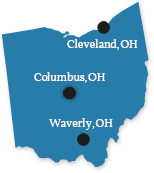Late last year, attorneys for Cuyahoga and Summit counties–including our own Frank Gallucci–reached settlements with multiple companies in some of the earliest opioid litigation. The settlements totaled about $280 million in cash, plus medications, charitable contributions, and attorneys’ fees. Around the state and across the country, this type of litigation continues. But the underlying problem is far from solved.
Many States and Counties are Still Working Toward Compensation
The Cuyahoga and Summit County cases settled early, but throughout Ohio and the rest of the country, state and local governments are still pursuing compensation for the damage the opiate epidemic has done to their citizens and their economies. State and local officials, mental health professionals, social service agencies, and others involved in the battle to minimize the impact of opioids on individuals and communities knew there was a lot of work still ahead. In fact, the crisis was headed in the wrong direction. After Ohio opioid-related deaths declined from 2017 to 2018, those numbers increased again. More than 4,000 opioid fatalities were reported in Ohio in 2019.
But no one anticipated a pandemic and the sudden life changes it would bring. The combination of challenges the coronavirus brought–isolation, loss of income, health concerns, and diminished options for support–negatively impacted Americans in many ways, including increased mental health challenges and substance abuse.
Rising Substance Use and Abuse During the Pandemic
The increase in substance abuse issues during the coronavirus shutdowns and related disruptions isn’t limited to opioids. The Centers for Disease Control and Prevention (CDC) reports that more 40% of thousands of U.S. adults responding to a survey in late June reported that they were struggling with mental health or substance use. The numbers were even higher among certain groups.
More than half of those aged 18-44 and more than half of essential workers reported at least one of these challenges. Two-thirds of unpaid caregivers for adults said they were struggling with mental health or substance use. The issues reported included anxiety, depression, and suicidal thoughts. 13% of respondents said they had started using or increased their use of substances.
New or increased substance use to cope with pandemic-related stress was more common among men than women, and most common among those aged 18-24, followed by those aged 25-44. Hispanics and blacks were more likely to be affected than whites. The likelihood of turning to substance use to manage anxiety and other issues was fairly consistent across income levels but was higher among those with lower levels of education than among those who had attended at least some college.
A special report from Millennium Health compared 500,000 urine samples to conclude that there had been a significant increase in non-subscribed substance use after the declaration of national emergency in mid-March. Specifically, the report showed:
- 31.96% increase for non-prescribed fentanyl;
- 19.96% increase for methamphetamine;
- 10.06% increase for cocaine;
- 12.53% increase for heroin.
In opioid-related fatalities, 2020 looks to be significantly outpacing 2019. As of August 20, there were 2,071 reported Ohio opioid deaths in 2020. As of the same date in 2019, that number stood at 1,599. That’s a 29.5% increase year over year.
Obstacles to Getting Help
Fighting addiction is always difficult, and many people encounter obstacles to treatment and support, ranging from fear of job loss or damaging relationships if they seek help to financial barriers and waiting lists. In 2020, however, people struggling with substance abuse and other mental health issues face new challenges. Some treatment centers have temporarily closed or reduced capacity after virus outbreaks.
Even where treatment facilities are operating under relatively normal conditions, some people struggling with substance abuse issues are fearful of seeking out in-person or inpatient care. Those live contacts, particularly in the inpatient setting, increase the risk of exposure to the virus. And, as Kaiser Health Network points out in the report cited above, people fighting substance abuse issues often have underlying conditions such as heart disease and diabetes. That means they’re at greater risk for serious illness or death if they do contract the virus.
In the early weeks of the pandemic, many treatment centers saw a 40-50% drop in patients. But that number has since rebounded to about 80% of the norm. While the coronavirus-related risks are real and shouldn’t be ignored–especially by those with high-risk medical conditions–those risks must be weighed against the risk of untreated addiction. Even if you’re wary of entering an onsite treatment program, there’s no harm in reaching out to learn more about the resources available to you. Some providers even offer telehealth services for those struggling with opioid addiction.
In Ohio, one easy way to get started is to dial 211. This service, provided by the United Way, helps people find resources and services in their own communities.
Plevin & Gallucci continues to advance the fight against opioid manufacturers, distributors and retail pharmacy chains in the courtroom. While there has been some initial success in helping a few communities, the overall strategy of the litigation is to provide a remedy and the resources necessary to recover from the epidemic to the entire country.

